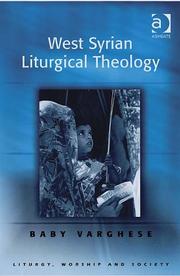| Listing 1 - 10 of 31 | << page >> |
Sort by
|

ISBN: 075460618X 0754606198 9780754606185 9780754606192 Year: 2004 Publisher: Aldershot Ashgate
Abstract | Keywords | Export | Availability | Bookmark
 Loading...
Loading...Choose an application
- Reference Manager
- EndNote
- RefWorks (Direct export to RefWorks)
Liturgics --- Syrian Church --- Liturgy --- Doctrines --- 264.018.3 --- 264.018.3 Syrische, Jacobitische ritus --- Syrische, Jacobitische ritus --- Church of the East --- Old East Syrian Church --- Nestorian Church --- Assyrian Church of the East --- Chaldean Catholic Church --- Doctrines. --- Liturgy.
Book
ISBN: 9783447117463 344711746X 9783447392204 Year: 2021 Publisher: Wiesbaden Harrassowitz Verlag
Abstract | Keywords | Export | Availability | Bookmark
 Loading...
Loading...Choose an application
- Reference Manager
- EndNote
- RefWorks (Direct export to RefWorks)
The present study is an overview of the general development of the Syriac liturgical traditions until the end of the 13th century. It traces some of the aspects of the encounter between Syriac Christianity and its surrounding cultural milieu. Literary genres and styles from the Early Jewish, Mesopotamian, Syro-Hellenistic and Arabic cultures were adapted in a process of encounter and inculturation. Along with Judaism, Mesopotamian pre-Christian and non-Christian cultures provided poetry, music and kinetic arts (gestures, movements and processions). The demonstrative piety of Antioch and Edessa has left traces of influence on the early Syriac liturgy. A few pagan and agrarian festivals were adapted, giving a Christian meaning. Throughout its history, Syriac liturgy is characterized by adaptability which is particularly evident in the history of the East Syriac Church in Central Asia and China where the liturgy was adapted to the culture of the nomadic tribes, introducing some unique para-liturgical practices.
Book
ISBN: 9783447119641 3447119640 9783447393669 3447393661 Year: 2023 Publisher: Wiesbaden: Harrassowitz,
Abstract | Keywords | Export | Availability | Bookmark
 Loading...
Loading...Choose an application
- Reference Manager
- EndNote
- RefWorks (Direct export to RefWorks)
About four million Syriac Christians, living in the South Indian State of Kerala with important diaspora in India and outside, are following East or West Syriac liturgical traditions. They are popularly known as St Thomas Christians, as they are believed to have been evangelized by the apostle Thomas. As these Christians were in intermittent relationship with the Syriac Christianity in Mesopotamia since the early centuries, they are also known as Syriac Christians. At least since the sixth century, perhaps fourth century, they were following East Syriac Liturgy. In the sixteenth century several East Syriac Prelates, both Catholics and non-Catholics, introduced the East Syriac liturgy in its final form. Since the middle of the sixteenth century nearly half of them are following the West Syriac liturgy. Their liturgical practices provide examples of liturgical conservatism and radical reforms. Now the liturgical texts have been translated into Malayalam, language of Kerala, and English, Hindi or other regional language for the use of the diaspora. However, Syriac is used by several clergy. Syro-Malabar liturgy is a highly latinised form of East Syriac liturgy, followed in the Eastern-Catholic community. Malankara Orthodox Church follows the liturgical rites of the Syrian Orthodox Church of Antioch. History of the Marthoma liturgy, a reformed version of the West Syriac liturgy and used by the Reformed group, is presented here for the first time for the students of Syriac Christianity and liturgy.
Book
Year: 1989 Publisher: Lovanii: Peeters,
Abstract | Keywords | Export | Availability | Bookmark
 Loading...
Loading...Choose an application
- Reference Manager
- EndNote
- RefWorks (Direct export to RefWorks)
Book
Year: 1989 Publisher: Lovanii : Peeters,
Abstract | Keywords | Export | Availability | Bookmark
 Loading...
Loading...Choose an application
- Reference Manager
- EndNote
- RefWorks (Direct export to RefWorks)
Unction --- Baptism --- Syrian churches --- History. --- History. --- Customs and practices.
Book
Year: 1989 Publisher: Lovanii Peeters
Abstract | Keywords | Export | Availability | Bookmark
 Loading...
Loading...Choose an application
- Reference Manager
- EndNote
- RefWorks (Direct export to RefWorks)
Book
ISBN: 9781463219734 Year: 2009 Publisher: Piscataway, NJ
Abstract | Keywords | Export | Availability | Bookmark
 Loading...
Loading...Choose an application
- Reference Manager
- EndNote
- RefWorks (Direct export to RefWorks)
Book
ISBN: 9781463224943 Year: 2011 Publisher: Piscataway, NJ
Abstract | Keywords | Export | Availability | Bookmark
 Loading...
Loading...Choose an application
- Reference Manager
- EndNote
- RefWorks (Direct export to RefWorks)
Book
ISBN: 9781463224950 Year: 2011 Publisher: Piscataway, NJ
Abstract | Keywords | Export | Availability | Bookmark
 Loading...
Loading...Choose an application
- Reference Manager
- EndNote
- RefWorks (Direct export to RefWorks)
Book
ISBN: 9781463232573 Year: 2012 Publisher: Piscataway, NJ
Abstract | Keywords | Export | Availability | Bookmark
 Loading...
Loading...Choose an application
- Reference Manager
- EndNote
- RefWorks (Direct export to RefWorks)
| Listing 1 - 10 of 31 | << page >> |
Sort by
|

 Search
Search Feedback
Feedback About UniCat
About UniCat  Help
Help News
News